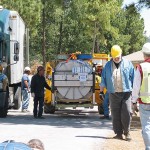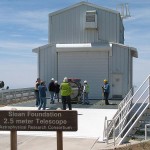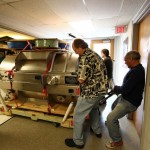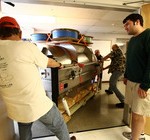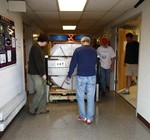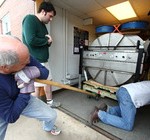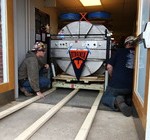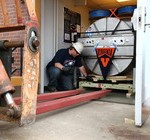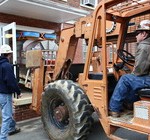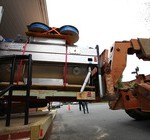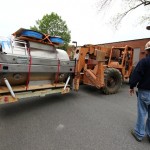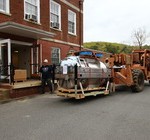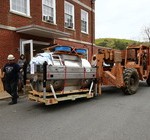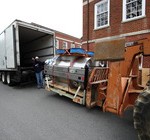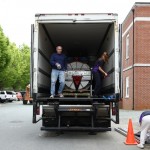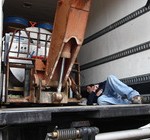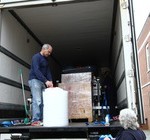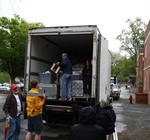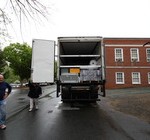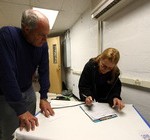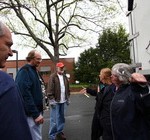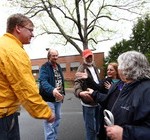The 2011 SDSS-III collaboration meeting is being held at Vanderbilt University in Nashville. Over 3 days (Aug 12-15th), over 100 scientists are discussing their new results and achievements. Below is a group photograph.

Uncategorized
What types of galaxies are in BOSS?
A critical question for the SDSS-III BOSS is what kinds of galaxies are they observing. In a recent paper by Masters et al., SDSS-III scientists used additional, higher resolution data from the Hubble Space Telescope (HST) to answer this questions.
In SDSS images, BOSS galaxies, which are on average about 6 billion light years away, just looks like fuzzy red blobs. The goal of BOSS is to observe 1.5 million of them over 30% of the sky in order to map the large scale structure in great detail. For this study, they took a look at a tiny subset of 230 of them which have deeper HST images (which were taken as part of the COSMOS project – the largest area HST survey every yet done).
The study found that 75% of BOSS galaxies are massive ellipticals, but that a surprisingly high fraction (20%) of these are split into multiple components in the HST images. The remaining 25% of BOSS galaxies are massive spirals.
The image below shows an example of one of the spirals and one of the ellipticals shown in both the SDSS and HST image.
As well as the paper, you can look at a poster about this work which was presented both at the AAS in Boston in May, and also at the recent Galaxy Formation conference in Durham
Finally if you want to browse all the images yourself they are available at www.icg.port.ac.uk/~mastersk/BOSSmorphologies/
APOGEE in action
The commissioning of APOGEE is now in full swing as the team works out the capabilities of the new spectrograph. Quite remarkably, because APOGEE is an infra-red spectrograph, it can operate perfectly well in relatively bright observing conditions compared to the more traditional optical instruments used previously by SDSS. As shown below, APOGEE can take observations of the bulge component of our Galaxy in full moon and over the lights of nearby El Paso.
The APOGEE team below in the SDSS telescope control room during the first light observations in May 2011.
Astrometry errors in DR8
We would like to alert our users of large astrometry errors that we have identified in the SDSS Data Release 8 photometric catalog. In particular, the regions not covered by UCAC2 (north of around 41 deg declination) the DR8 astrometry is offset 240 mas to the North and 50 mas to the West. The declination offset is nearly uniform in the affected area (at an rms level of about 60 mas). Users trying to perform proper motion analysis, detailed astrometry, or performing spectroscopic observations should be aware of these shifts. A full description of our understanding of the errors and quality assessment plots can now be found in our description of the DR8 astrometry.
These problems are currently being addressed and we plan to add supplemental tables with correct astrometry to the DR8 release. We will incorporate the new astrometry as the default for the DR9 data release.
An erratum has been prepared for submission to the Astrophysical Journal to correct the Data Release 8 paper’s statements on this issue.
Cross-matching between DR7 and DR8
In January, the SDSS collaboration released Data Release 8, including a much larger area of sky, with photometric data for nearly 500 million sky objects, and spectra for more than 1.5 million.
As always, data from all previous releases is still available also. New this week is the ability to cross-match sky objects between Data Release 7 and Data Release 8. If you have object IDs and parameters for a specific object from DR7, you can query for the same object in DR8.
The cross-matching is available three different ways:
SpecDR7: This is a unique match between a DR8 SpecObjAll and a DR7 photoprimary within 1 arcsec. DR7 PhotoTag columns and relevant DR7 ProperMotions are also included for convenience.
PhotoPrimaryDR7: This is a unique match between a DR8 photoprimary and a DR7 photoprimary, and matches between different run/camcol/field are allowed. The match radius is 1 arcsec. The table contains the DR8 and DR7 objids, the distance between them and the DR7 PhotoTag quantities.
PhotoObjDR7: This is a unique match between a DR8 photoobj and a DR7 photoobj, and matches are restricted to the same run/camcol/field are allowed. The match radius is 1 arcsec, and within this radius preference is given to a photoprimary match over a secondary. If no primary match exists, the nearestsecondary match is chosen. If more than one match of a given mode exists, the nearest one is chosen. The table contains the DR8 and DR7 objids and modes, the distance between them, and the DR7 phototag quantities.
Media Superstar
I have just returned from the four-day visit to the April meeting of the APS (American Physical Society) – a big meeting where physicists from many field come together, share the scientific news, take political stances and discuss the evolution of the profession. I was presenting our latest results on the three-dimensional Lyman-alpha forest and did so twice: on Sunday morning to the press and on Sunday afternoon to the scientists.
In the morning press conference me and two other hopefuls were showing our results to some fifteen journalists. It is an interesting exercise as you try to make your science appear as interesting and exciting as possible, while at the same time avoid making it neither too unintelligible nor overly dumbed down. Ultimately, the biggest problem is that what makes scientists tick is not what makes a good story. Although they looked suspiciously sleepy to me while I was waving my hands vigorously, we did a good job as you can read via Google News .
The afternoon talk was given to a bunch of physicists, which, however, were not astronomers. This was hard in a different way: I had to make a valid scientific argument about why what we did is interesting and important to an audience who understand physics, but are not experts in the cosmology. I had a good impression, but alas, one cannot browse the web to see what impact did I impress onto those guys and gals.
Words by Anže Slozar , lead author on the recent analysis of the lyman-alpha forest clustering seen in the quasar spectra from BOSS. Anže presented his results to both the press and fellow physicists, and the SDSS-III press release can be found on the main SDSS-III website
If you want to see more of Anže, then check out his youtube video
Don’t drop it!
On April 25th, the APOGEE spectrograph arrived at Apache Point Observatory, ready for installation in the SDSS buildings and in preparation for first astronomical light. We provide below some photos of the arrival.
- 3761
- 3771
Above: Outside the 2.5m SDSS telescope being prepared for lowering into the SDSS-III spectrograph room.

Above: Finally inside!
Photos by Gretchen Van Doren
APOGEE heads west!
On Friday April 22nd 2012, the APOGEE spectrograph left its integration lab at the University of Virginia and was loaded onto a truck headed to Apache Point Observatory in New Mexico for installation and commissioning in the coming weeks. We provide here a photo blog of that process.
Below: The APOGEE team carefully guides the several ton instrument out of the integration lab. The cryostat is resting on a specially designed shipping palette including several means of shock absorption. On top of the cryostat are the reels holding the three hundred, 40-meter long fiber optic links that will eventually connect the spectrograph to the Sloan 2.5-m telescope. Team members pictured from left to right: Paul Maseman, Eric Walker, Steve Majewski, David Nidever and Fred Hearty.
- img 3391
- img 3405
- img 3415
- img 3432
Below: University of Virginia Dept. of Astronomy chair, John Hawley, looks over the proceedings. Visible is the optical fiber feedthrough end of the spectrograph.
Below: The APOGEE spectrograph positioned at the loading dock.
Below: Loading and lifting the APOGEE spectrograph with the frontloader. The fiber optic feedthrough and grating end of the spectrograph is that farthest away from the frontloader, while the collimator end is closest.
- img 3502
- img 3513
- img 3528
- img 3533
- img 3538 sml
- img 3550
- img 3552
- img 3553
Below: Loading the APOGEE instrument onto the air-ride truck.

Below: Project manager Fred Hearty directs loading of the truck with the APOGEE spectrograph and other palettes of ancillary gear.
- img 3603 sml
- img 3597
- img 3614
- img 3625
- img 3640
Below: Signing over responsibility of moving APOGEE to the “custom critical” shipping company, and wishing the drivers a safe trip!
- img 3642
- img 3645
- img 3648
Below: Mixed emotions after a long and exciting week…
Congratulations to the APOGEE instrument team for an amazing job! And thanks to all of SDSS-III for the incredible support.
Below: Some of the local APOGEE team members involved with APOGEE loading day activities standing in front of the instrument poised for shipping: (left to right) Ana Garcia-Perez, Eric Walker, Adam Burton, Matt Nelson, Fred Hearty, Charles Lam, Paul Maseman, Steve Majewski, David Nidever. At the time of all of this moving activity at UVa, APOGEE Instrument Scientist John WIlson was in Baltimore busily making last measurements and adjustments to several APOGEE optical elements with the Johns Hopkins University team (Robert Barkhouser and Stephen Smee); these last elements of the instrument were shipped out on Saturday. Also missing from the photo are Jim Barr, Janice Dean and Lihong Yao, as well as Mike Skrutskie, head of the UVa instrument lab, who, on top of providing experienced help loading up the APOGEE hardware for shipment, had also to duck out to teach a class!
(All photos by Guillermo Damke.)
Shipping out!
After a successful pre-shipment review last Friday, the Instrument and Science Teams of APOGEE have been given approval to ship the nearly-completed spectrograph to the Apache Point Observatory in three weeks. This approval was based upon completion of planned laboratory integration and testing to demonstrate that the instrument will ultimately meet science requirements; a list of open items and on-site commissioning activities remain to be completed before the instrument is fully ready for the “official” start of survey operations. The most critical identified open items are fine-tuning detector focus and correcting some astigmatism identified during lab testing. Additional integration challenges await the Teams when the instrument begins on-sky commissioning. First Light on the Sloan 2.5m telescope is anticipated 2-3 weeks after the instrument is shipped. Stay tuned.

Red, Green, and Blue Detectors recording infrared sunlight on 300 individual fibers. The spectra cover from 1.69 to 1.51microns (left to right).
Fast Breaking Paper
Science Watch has provided a commentary on the SDSS-II paper by Reid et al. (2010) cosmology paper which has been classed as a “fast breaking paper” because of the rate of citations the paper has received already. Beth Reid provides a short summary of the paper and discusses the success of the SDSS.
More pictures from BOSS meeting
BOSS scientists at APO
The BOSS collaboration has now finished their meeting in Cloudcroft, which included several trips to nearby Apache Point Observatory to see the Sloan Digital Sky Survey (SDSS) in action (and even help with observations). We include below a series of photos (taken by Emmanuel Rollinde from IAP) showing the BOSS scientists getting to grips with BOSS and the SDSS telescope

First, need to get a plate (on top) to observe, which are installed in cartridges (one seen at the bottom)

Fill up the (green) BOSS spectrographs with liquid nitrogen to keep the detectors cool during the night
Finally, we provide below two video showing the APO observers and BOSS scientists getting ready for a nights fun. Thanks to Emmanuel Rollinde and Stephanie Snedden for them.
[youtube http://www.youtube.com/watch?v=Kjvt7MVb32U&w=640&h=390]
[youtube http://www.youtube.com/watch?v=u-I9N80V47U&w=480&h=390]
BOSS in New Mexico
The SDSS-III BOSS is holding their collaboration meeting in Cloudcroft, New Mexico at the moment. Cloudcroft is the nearest town to the Apache Point Observatory, where the Sloan Digital Sky Survey (SDSS) telescope is located. The meeting has nearly 100 scientists, from across the world, and each evening these scientists have the opportunity to visit APO and see the SDSS telescope in action. For many of them, it is the first time they have seen the telescope that is collecting their data.
Below are two photos from the first day of the meeting, showing BOSS astronomers arriving at the Lodge in Cloudcroft (where the meeting is being held), and then a photo showing them hard at work. Photos taken by John Parejko.
Radio interview about SDSS-III
Bob Nichol (SDSS-III Spokesperson) gave an extended radio interview to the Planetary Society about the SDSS-III survey. The interview which lasts over 10 mins includes a discussion about the DR8 terapixel image, Galaxy Zoo and public interaction with Science, and the SDSS-III survey.
The interview can be downloaded here
APOGEE observes the Winter Hexagon
On the frigid winter night of January 22, 2011, the APOGEE project had its first successful “observing run”. With one of the instrument-installed APOGEE fiber bundles passed through the window of the instrument assembly lab at the University of Virginia (UVa) and then coupled to a modified 10-inch Newtonian telescope just outside, APOGEE took its first spectra of other stars, as well as the planet Jupiter and the Orion Nebula.
The 10-inch telescope modification, a project of first year UVa graduate student Ben Breslauer, uses a dichroic to split optical light, sent to the Newtonian focus for acquiring and guiding objects by eye, from infrared light, sent to the prime focus where fibers in a special “mini-plugplate” receive the light to send on to the APOGEE instrument. The telescope is a scaled down version of the Sloan 2.5-m telescope, with the same f/ratio but 1/10 the diameter. With this arrangement, the 10-inch telescope sees the same diffuse background flux as expected at Apache Point and can, in principle, observe stars 5 magnitudes brighter than the 2.5-m telescope to the same signal-to-noise. But to make the acquisition and guiding easier and to ensure that fibers receive a steady stream of light, the telescope is actually used with the star images out of focus. Nevertheless, many bright and interesting astronomical objects are within easy reach of the system.

Ben Breslauer, coupling one of the 40-meter long APOGEE fiber runs from the instrument to a fiber ``harness" attached to the telescope, with 30 individual fibers plugged into a mini fiber plugplate at the prime focus of the 10-inch telescope. The fibers are arranged to span almost a 1.5 degree field of view
The goal of the 10-inch telescope project is to obtain data for assessing the APOGEE instrument performance, guiding and testing the APOGEE data reduction software pipelines, and understanding the properties of the near-infrared sky background at APOGEE’s high resolution. On the first night of observation, stars from the famous “Winter Hexagon” were observed. Interestingly, the Winter Hexagon (plus Betelgeuse, in the center of the Hexagon) provides a remarkably diverse range of spectral types useful for assessing the broad range of star temperatures that APOGEE will explore in its survey of the Milky Way. The APOGEE science team is now analyzing these important early data in a variety of ways to understand the infrared “airglow”, the spectrograph throughput, and the challenges of observing with an instrument providing such rich spectral information on stars.

A portion of the APOGEE spectra collected with the 10-inch telescope in January, showing the large diversity of spectral types in the Winter Hexagon. The top spectra, with the richest density of lines, are most representative of the expected typical APOGEE spectra (most targets will be of G, K and M spectral type). The wavelengths shown span less than 1/3 of the total APOGEE spectral region. Image by Carlos Allende-Prieto and David Nidever

The APOGEE instrument team, eagerly awaiting the first APOGEE night time spectra after their dogged and successful efforts to get the spectrograph to this point in so short a time (the APOGEE Critical Design Review was in August 2009). APOGEE instrument scientist John Wilson is in the foreground, on the right, standing next to David Nidever, who tirelessly worked to get the software reduction pipeline ready to work on the data. In the background are team members Mike Skrutskie (head of the instrument lab), Bob O'Connell, Matt Nelson, and Fred Hearty (project manager), running the instrument just outside the APOGEE assembly room




